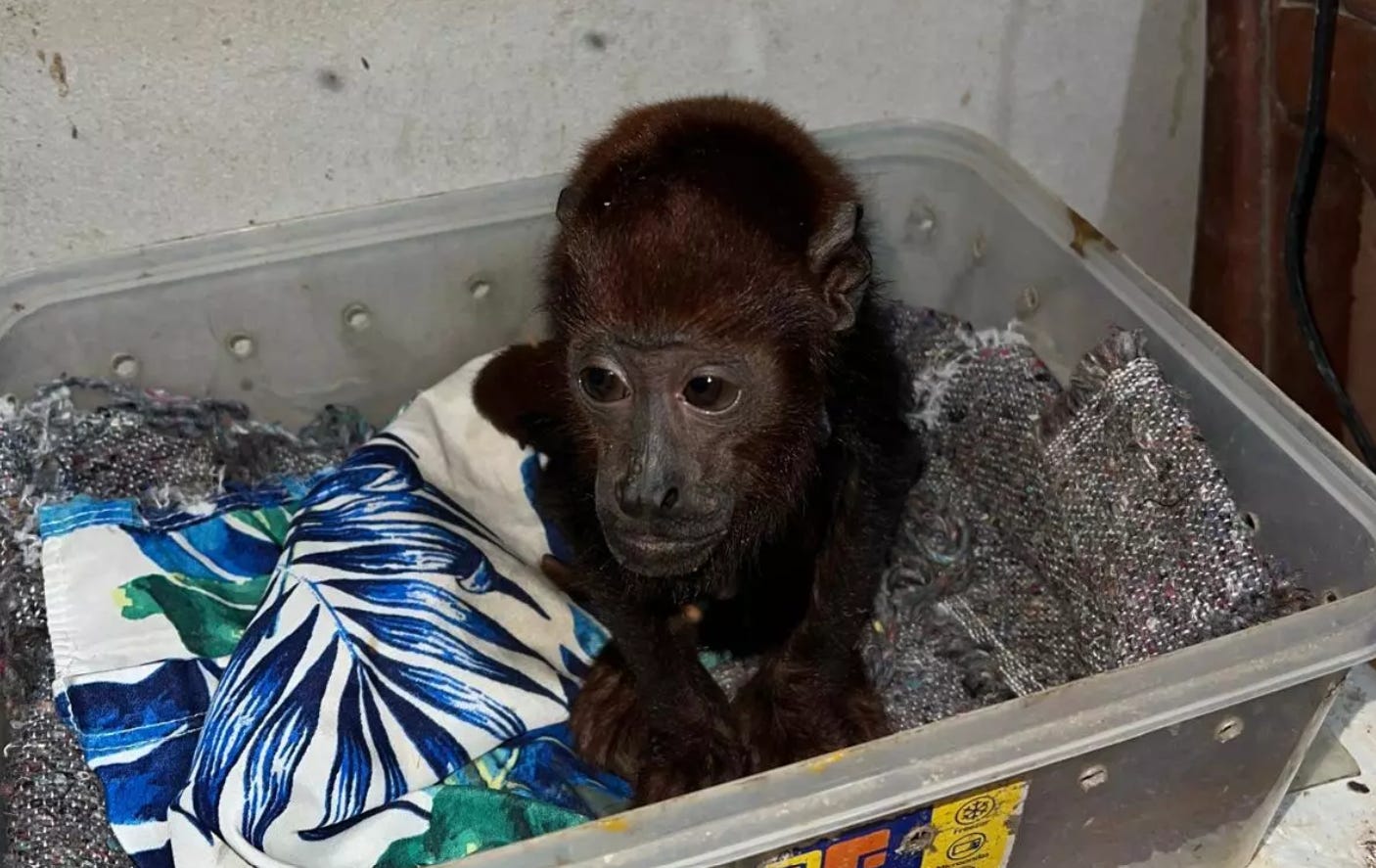An ocelot, a Spaniard, and 1,400 animals
Inside Operation Green Shield: how a Middle Eastern country carried out a major environmental crime crackdown in the Amazon
The gang called itself “The Predators of the East”. In late July it became the hunted when dozens of officers from the Peruvian National Police stormed its headquarters in the Amazonian city of Iquitos.
Inside, officers found a grim menagerie: juvenile monkeys, sloths and even an ocelot were found in various states and bound for the illegal wildlife trade. The gang may have made more than $1.5m since 2022, according to authorities. Twelve people, including a Spaniard alleged to be the ringleader and five local government officials, were arrested. Some 1,400 animals were rescued.
The raid, supported by the US Fish and Wildlife Service, was part of a much larger operation called Green Shield. Led by the United Arab Emirates, it comprised coordinated raids across four countries in one of the largest crackdowns on environmental crime in the Amazon Rainforest. More than 1,500 officers from Peru, Brazil, Colombia, and Ecuador made 94 arrests across two weeks, seizing $64m in assets.
Why the Amazon matters
The Amazon is a vitally important hub of biodiversity. It is home to about 10 per cent of all species on Earth and produces an estimated 20 per cent of fresh water on the planet through its basin system, as well as serving as a significant carbon sink. It spans 6.7m square km – roughly similar to the continental US – and sits across nine countries, although the bulk is found in Brazil.
But it is under threat. Deforestation is swallowing up its trees driven by cattle farming, illegal mining and other types of environmental crime. Its animals are poached to fuel the illegal black market in wild animals, while its waters are poisoned by mercury released by gold miners.
Coordinated strike
Green Shield was an attempt to coordinate law enforcement efforts across the Amazonian countries. From a control centre in Colombia’s capital Bogota, agencies used real-time data to carry out 350 raids across the region.
In total, officers seized 310 tonnes of raw minerals, 3,800 cubic metres of timber and tens of thousands of gallons of smuggled fuel. The seizures represent a cross-section of the environmental crimes with which the Amazon is plagued. Illegal gold miners, often linked to violent armed gangs, are driven by the high price of gold, while illegally felled timber is often ‘laundered’ into the legal trade with falsified or altered permits. Illegal Amazonian timber has been linked to decking sold in the United States, according to NGO reports.
In addition, the operation shone a spotlight on the size of the illegal wildlife trade from the region. Authorities seized more than 2,100 live animals and discovered another 6,000 dead. The illegal wildlife trade is highly lucrative and the relatively lighter sentences, compared to the smuggling of drugs or weapons, makes it an attractive sideline for criminal syndicates.
Challenging conditions
Enforcing the law is challenging in a region comprised of dense jungle which spans multiple countries and jurisdictions. To get around some of these challenges, officers used a geospatial software called ArcGIS, according to Mongabay. This displayed intelligence data in multiple languages and across several different sources. Police officers across the countries involved were able to share intelligence more easily, sharing locations and sending reports with pictures to the Bogota HQ in seconds.
Another factor in the protection of the Amazon is that many of the people living in the rainforest are indigenous. Many indigenous people are highly protective of the environment, with the land being a central part of their belief system.
But those who defend the Amazon often face a terrifying threat of violence. The Wampi Nation, an indigenous group living in northeastern Peru, has established its own environmental enforcement patrols in a bid to combat the growth of illegal gold mining in the area. They have been shot at while on patrol, demonstrating the risks that environmental defenders are exposed to. At least 296 defenders have been killed in the Amazon since 2014, according to Global Witness, and Latin America is the deadliest region worldwide.
Several raids were carried out in indigenous territories as part of Operation Green Shield and authorities pointed out that indigenous groups, living at the coalface of these crimes, are the most immediate victims. “These crimes directly impact indigenous communities, their land, their livelihoods, and their identity,” Emirati Lt. Col. Dana Humaid told the Associated Press.
A blueprint for global law enforcement?
The Operation represents an interesting example of internationally coordinated law enforcement. Humaid told Mongabay that the team “wanted to do things differently”. But it is the latest in a string of law enforcement efforts that have spanned borders. Operation Jaguar targeting poaching of the big cats across several Latin American countries between 2018 and 2021. Operation Cobra targeted rhino horn smugglers between 2013 and 2016.
As international trade and crime becomes increasingly globalised, it is no longer possible for any one country to carry out enforcement alone. An animal can be poached in Latin America, and smuggled to Asia via Europe. More coordinated policing can help intercept these illicit shipments at any point along that chain. As Diego Jiménez Salcedo of Ecuador’s National Police pointed out to Mongabay, criminal groups have logistical capabilities which move beyond borders. “We need the same,” he said.
The involvement of the UAE, a country several thousand miles from the Amazon, as coordinators is an oddity. Mongabay quoted Saeed Al Eissaee, of the UAE Ministry of the Interior, as saying that the country wants to position itself as a leader in environmental protection. He told the website that this would enhance the UAE’s “global influence and reputation… as a responsible actor”.
Whatever the motivations, Operation Green Shield succeeded in breaking up some criminal operations. Yet few expect gangs to step aside after one setback. Routes will change and techniques will be adapted. Law enforcement efforts will need to continue.


